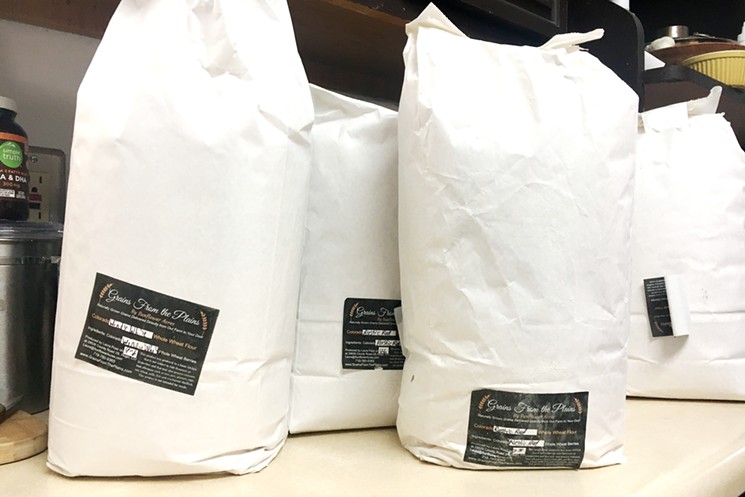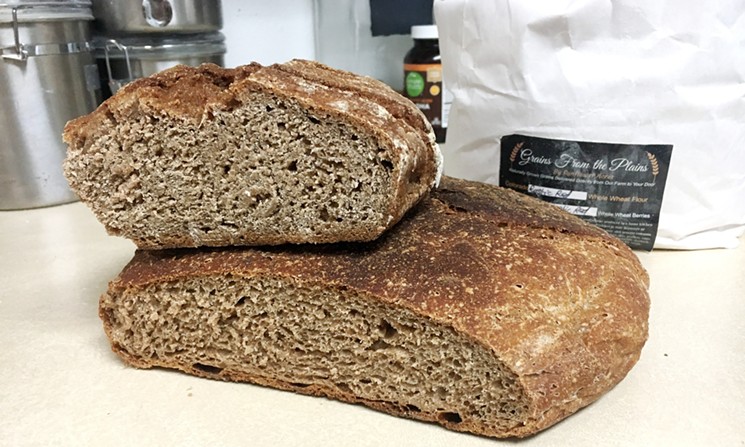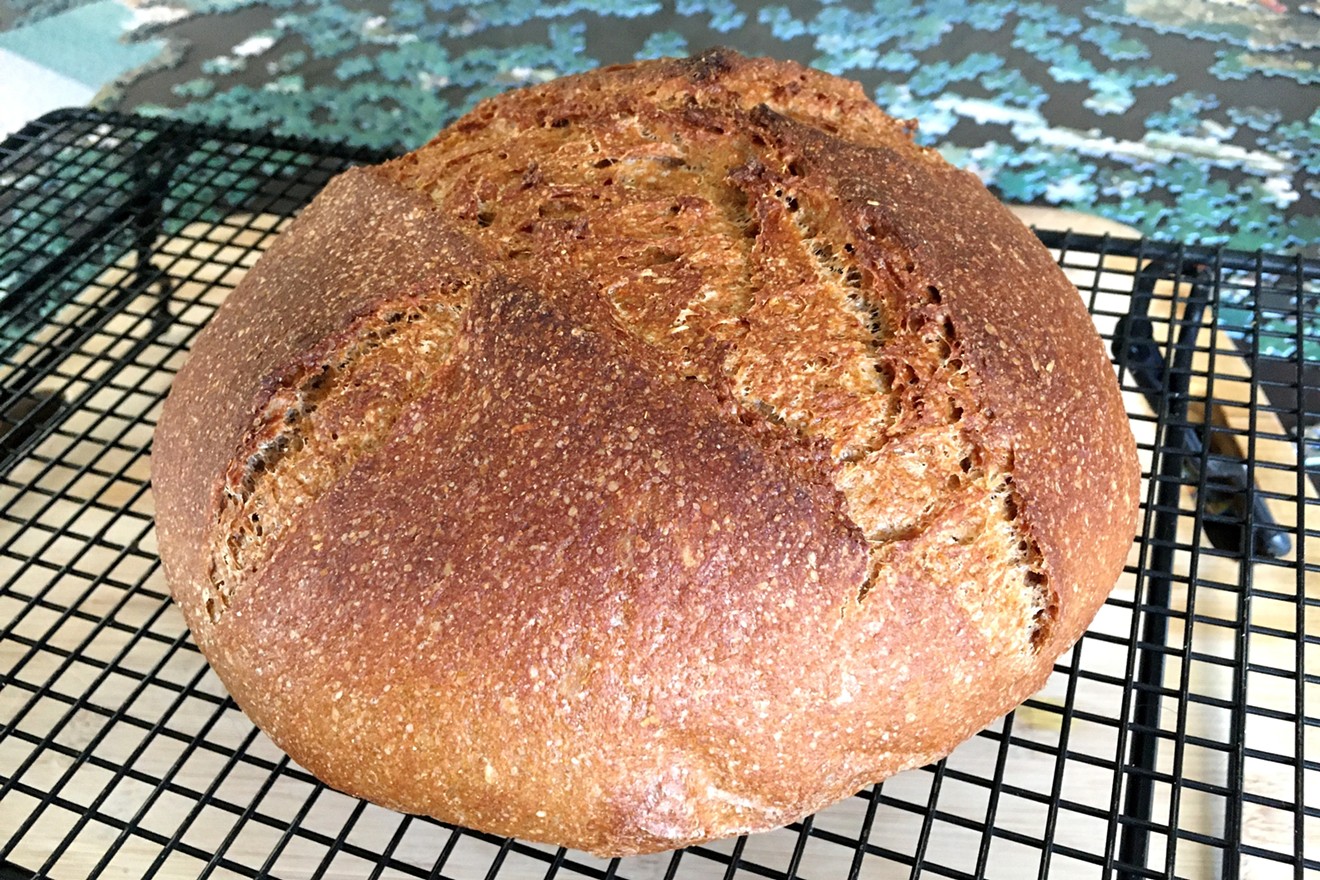After months of practice making sourdough bread, a brick was not the intended result.
Something had gone wrong, either in the ratio of flour to water, the activity of the sourdough starter (which had never failed before in the past eight months) or the long fermentation and rising time. But for this bread, I'd deviated from my standard all-purpose flour: I had just invested in fifty pounds of fresh-milled whole wheat flour from Grains From the Plains, a small business that sells wheat, eggs, dried peas and other products direct from the Sunflower Acres farm in Hugo, ninety miles southeast of Denver on the plains.
Baking with 100 percent whole wheat flour turned out to be a completely different experience from using the snowy-white stuff most of us keep on hand in our pantries — at least, which most of us kept on hand until recently, when panicked shoppers began buying up every non-perishable item on grocery-store shelves in preparation for holing up at home for the duration of the coronavirus pandemic. Flour is a staple in most home kitchens, but it's not a necessity. We generally use it to coat chicken or fish for frying, to whip up a quick batch of cookies or banana bread, or to turn out impressive cakes and pastries during holiday baking benders. If we run out, maybe we'll skip those brownies — or just zip to the store for another bag. But suddenly last month, we all thought that we would need flour — and yeast, which turned out to be right behind toilet paper and hand sanitizer as a most-coveted commodity — as a survival necessity.

Grains From the Plains typically delivers whole wheat berries but will mill it into flour for a small charge.
Mark Antonation
Then reality set in, along with boredom. Stuck at home with bags of flour and sachets of yeast, baking became a hobby to pass the time. And posting photos of every loaf, bun and baguette became a way to connect with friends we'd normally be meeting for happy hour or boisterous dinners, or to signal that everything was Martha Stewart-perfect on the home front (even if the beauty of many online photos was just a thin veneer to hide dread and anxiety).
My bread-making obsession began in college, when I was the primary dough mixer at a deep-dish pizza joint for about a year and a half, coming in to work hours before my co-workers to fire up the Hobart and turn out multiple 75-pound batches of silky dough. I took my work home, translating the big-batch dough recipe into a more manageable size,and adjusting it for cinnamon rolls, ciabatta and crusty baguettes. Over the years, the urge to bake has come and gone, but it was rekindled last summer when I obtained a sourdough starter from a grain booth at the Slow Food Nations food festival in Larimer Square.

The early efforts came up a little flat: attempt number one on top and number two on the bottom.
Mark Antonation
What I didn't know was that the Poss family was being overwhelmed with wheat requests. "Until a few weeks ago, it was mostly whole wheat berries for people who grind their own, but that changed," Laura notes. "We normally sell about 100 to 200 pounds a week, but now it's 1,500 pounds a week."
And that's tricky, because most of the farm's customers would buy whole wheat berries, so it doesn't have a commercial-sized mill; Laura just grinds small amounts to order for those who need it. But these new customers looking for alternatives to grocery-store wheat were all requesting ground wheat, not berries. "I was pulling all-nighters, grinding wheat all night," she reveals.
The orders have leveled off recently, and she's now able to manage the higher volume while getting a little sleep, but even my delivery order was delayed by a day as the family worked to catch up. Still, the Posses prefer to keep their operation at this level rather than selling commodity wheat to big companies. "My great-grandpa came here in the late ’20s or early ’30s from Kansas, and I'm farming some of the same land he did," Kevin says. "My family were commercial farmers, but we decided to sell direct to customers — and it's working really well for us."

Attempt number three turned out pretty good but didn't quite achieve the rise I was looking for.
Mark Antonation
Kevin leases 1,200 acres of land and follows organic practices (he's working on obtaining organic certification) to produce beef as well as grain. Rather than spraying herbicide to get rid of weeds, he begins tilling the weeds under in May and plants his wheat in September in rotating sections. The hard winter wheat sprouts in late fall and then goes dormant before growing tall in the spring for a June or July harvest. "We dry-land farm, so we don't irrigate," he points out. "We rely on Mother Nature."
In addition to the three types of wheat I purchased, the Posses grow Scout 66, a variety that Kevin's grandfather also grew (though Grains From the Plains is currently out of this one). Laura uses the farm's grains for hot breakfast cereals either lightly ground or cooked whole into a porridge, as well as for baking burger buns and other breads for Kevin and their seven kids.
While I felt a little guilty ordering my wheat already ground, I don't have plans to purchase my own mill (my kitchen is cluttered enough as it is). But I did need to find a new recipe for my sourdough experiments, since I didn't want to continue baking bricks. My first whole wheat failure was based on my old recipe, and it clearly didn't have enough water or enough time to allow the gluten to properly form the stretchy web within the dough that results in a good rise.
Thankfully, the Internet is filled with recipes and videos from people who have been doing this much longer than I have. I learned a new word in my online research: autolyse — the preliminary step of mixing nothing but flour and water and letting it sit for twelve hours before the sourdough starter is added. This additional step allows enzymes within the wheat to go to work, making the dough more pliable and, as a bonus, tasty.
My original recipe (from a New York Times article that adapts Chad Roberton's method from his book, Tartine Bread) called for 700 grams of water to 1,000 grams of flour (for two round loaves), but the new recipe is 90 percent water by weight. The technique is as important as the ratio, though; I autolyse the flour and water for twelve hours in the fridge before kneading in salt and my starter (which I keep in the fridge and take out and feed a day or two before I bake) and letting it rise and ferment for another twelve hours. Then I shape a loaf and let it double in size for several more hours before it goes into my Dutch oven, pre-heated to 450 degrees. I still don't get the impressive "oven spring" from the Grains From the Plains whole wheat that I do from all-purpose flour, but the result has a good crumb, with lots of small air pockets and a slightly stretchy feel that's the mark of good gluten development. Perfect? No — but at least I'm not wasting the efforts of the Poss family.
I sliced that first whole wheat doorstop thin and baked it into crackers so that it wouldn't go to waste, and I've stored most of my fifty-pound haul from Grains From the Plains so that it won't go rancid before I'm ready to work with it. For those considering stocking up, I'd only warn that fresh-ground whole wheat flour is not a one-to-one substitute for grocery-store flour, or even store-bought whole wheat flour. It takes time (something many of us have more of right now) and patience (which may be in short supply) to come up with a good result, and wheat just isn't as much of a necessity as, say, giant bags of frozen pizza rolls or tater tots.
If you're willing to learn something new, though, your baking skills could rise to a whole new level.
Here's my Rustic Red whole wheat bread recipe, as adapted from the Elly's Everyday YouTube channel. You'll need a Dutch oven or other heavy, oven-safe pot with a lid, a digital scale that measures grams, and your own sourdough starter (there are many recipes for this online, but it takes about two weeks to get one ready for baking):
400 grams water
450 grams whole wheat flour
130 grams sourdough starter (made with 50 percent flour and 50 percent water)
9 grams of kosher salt
Mix the flour and water together in a large bowl until they form a uniform mass, then put it in your fridge for twelve hours.
Remove the dough from the fridge and let it come to room temperature (about a half-hour). Spread it out flat on a wooden board, then spread the starter over it. Fold the dough in half and sprinkle on half of the salt, then fold it in half again and sprinkle on the rest of the salt. Knead the dough gently to fully incorporate the starter and salt (the dough ball will become sticky and a little shaggy).
Put the ball in a covered bowl (I use cling wrap) and let it rise for twelve hours at room temperature. Once it's bubbly and risen, imagine your dough ball as a tiny globe and stretch each quadrant — north, south, east and west — over the rest of the ball. Do this once every half-hour for two hours, then form the dough gently into a ball with a taut "skin" on top (you may need to watch the video to see how this is done).
Place the ball in a bowl that's been floured or onto parchment paper and then into the bowl, and let rise for two more hours. If you use parchment paper, you can just lift the whole thing out of the bowl and into your lidded baking pot preheated to 450 degrees, or very gently pick up the dough and place it in the pot. Replace the lid and let it bake in the oven for 25 minutes, then another 15 minutes with the lid off. With any luck, you'll have a deep-brown loaf with a crackly crust and a soft, airy interior.













